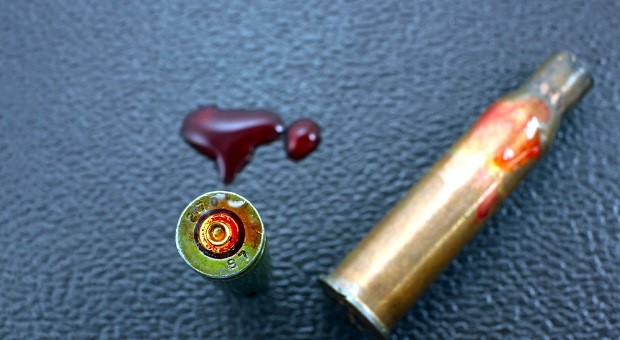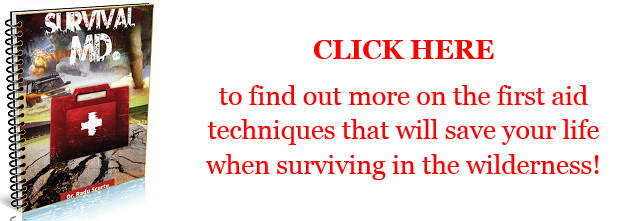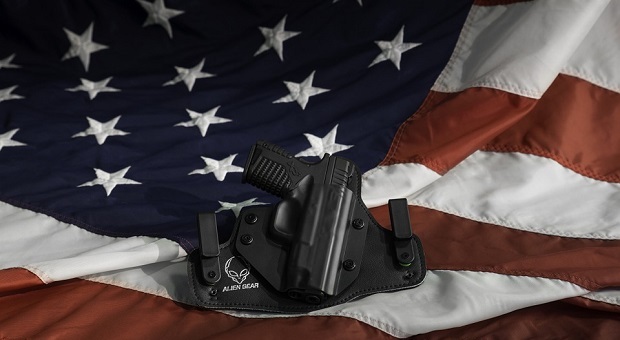Aside from being a traumatic experience, getting shot can also leave you with life long scars and a range of medical issues. Even though you will eventually need to get to a hospital or have the bullet removed by someone that knows how to do the job, there are also things you can do before and just after being shot that will improve your chances of survival.
In a time of major crisis where there may not be medical care available, or you are in a location where you cannot get to a doctor, taking steps beyond the most routine care can give you more time to gain assistance.
Recognize that Any Gunshot Wound Can be Fatal Under the Right Conditions
Under many circumstances, a gunshot wound to the and or foot, or even one that grazes the abdomen or face aren’t likely to be fatal. As long as the bleeding is stopped in time and no serious infections develop, even some of the more damaging gunshot wounds will not be fatal. That all being said, here are some situations where even a minor gunshot would can cost your life:
- There are multiple gunshot wounds in “non-fatal” areas. For example, if you have several wounds in the arms or legs, they will each bleed and cause you to drain out faster.
- A single gunshot wounds comes into contact with something with deadly germs in it. A gunshot wound to your hand that is exposed to water, sewage, or anything else that can seep into the wound can lead to the rapid development of a blood infection or sepsis. This, in turn, can kill in a matter of days to weeks even with the best antibiotic treatments.
- You are not properly vaccinated for tetanus or your immune system and health are compromised for some other reason. While blood loss related to gunshot wounds is bad, the post-shooting infections are every bit as deadly, if not more so. As with any other injury for an immune compromised person, the infections created by an otherwise minor gunshot wound can kill.
Tetanus and Other Important Vaccinations
As you may be aware, Tetanus or Lockjaw is a bacterial infection that you get when an open wound comes into contact with the bacteria. Since it is can be fatal or very difficult to treat, many people get vaccinations in order to avoid getting sick. There are also other vaccines you should look into for water borne and soil borne diseases. Any time an injury is sufficient enough to break the skin or cause bleeding, there is a chance for infection.
Not so long ago, the scares related to vaccines were considered the work of quacks and misguided fools. Now, there are many creditable studies linking vaccines to various diseases and medical conditions. In some cases, the vaccine injuries are caused by contamination, while others are caused by the inclusion of known toxins such as mercury (thimerasol). Before you get any vaccine, it is very important to do your own research on different vaccine manufacturers and their ingredient lists. Do not hesitate to ask your doctor who manufactured the vaccine they are giving you, the lot number, and other information that you need in order to do your research.
Building Up Your Immune System
There is no such thing as being able to vaccinate yourself against every possible fungal, bacterial, viral, or prion based disease pathogen. This is why it is very important to keep your immune system in optimal condition. If you do get shot and survive the blood loss, a strong immune system will give you the best chance to live and recover as quickly as possible. Here are some basic do’s and don’ts for having a strong immune system:
- Contrary to the belief of many preppers, it is never a good idea to take antibiotics before they are actually needed. Modern antibiotics are designed to kill off bacteria so long as the pathogen has not yet developed a tolerance to the drug. Sadly, modern antibiotics act to kill off the good bacteria in your intestines. More and more research indicates that these bacteria also play a huge role in the immune response that your body launches against many kinds of pathogens. If you use antibiotics when they aren’t needed, you may be destroying your body’s best immune system elements and not getting anything of value in return.
- The best way to build a healthy immune system is to build up the rest of your body. Get quality sleep, vigorous exercise, avoid air, water, soil, and food based pollutants and toxins. Investigate everything that is going on around you and entering your body. If you find something harmful or dangerous, do not hesitate to use government resources and the power of the vote to resolve the issue. It is also just as important to avoid buying products that will harm your health.
- There are also some vitamins, foods and herbs that can help you have a stronger immune system. This includes Vitamin C, leafy green vegetables and berries, and Echinachea. If at all possible, grow your own foods in a controlled setting in order to avoid GMO and pesticide tainted edibles. Unfortunately, in many cases, the benefits you hope to gain by eating healthier foods is all but erased because of these toxins. At this time, there is no way to find out what pesticide residue may be found on commercial foods, and GMO labeling is insufficient. It is best to grow your own foods and herbs from certified heirloom, non-hybrid seeds, and then produce successive generations of plants from the seeds that are part of each successive crop.
Items to Have in Your Emergency Kit
Before getting into basic first aid for one or more gunshot wounds, it is important to know what tools are best to have on hand. There are many different supplies that will meet these needs to varying degrees. If you have your prepper gear divided into pocket, every day carry (EDC), bug out bag, auto carry, and shelter caches, then you can choose items from each listing that will fit into each supply container. In an emergency, something is always better than nothing, so don’t underestimate what you can do with a just a few simple items and the knowledge of how to use them to the best advantage for any given goal.
- Restraining devices – If the gunshot wound itself isn’t hurting at the moment, you can rest assured there will be plenty of pain when you start digging into it in order to stop the bleeding. Bed sheets and blankets make a good restraint device. They are also useful if the victim is showing signs of shock as you can wrap hand warmers, hot water bottles, and other heating aides into the sheets. If you do not have proper training in the use of medications, do not attempt to use drugs that will render the individual unconscious, even for a few minutes. While there are herbs and other items on the market that can be used to achieve this goal, they can do more harm than good in unskilled and untrained hands.
- Tourniquet – This is, easily, one of the most important items to have on hand for treating wounds that cause a lot of bleeding, and also as a “last ditch” item for treating gunshot wounds to the extremities. Items as simple as thick rubber bands, a tie or shirt, and a sturdy metal pen can be used to make a tourniquet. You should always have these items on hand in everything from your pocket/body carry to any bug out shelters you are planning to use in a time of need.
- Pressure bandages – Pressure bandages are considered the most important first aid device for treating gunshot wounds. Fortunately, the materials for making a pressure bandage are also very easy to carry in your pocket and any other container you are using for emergency supplies and tools. At the simplest, you can keep some gauze pads and duct tape on hand, or choose other supplies. To keep duct tape in your pocket or other limited space EDCs, simply take some from a roll and fold it over on itself so that the sticky side meets the outer side, just as it is on the roll. Do not forget to make a small tab on the end so that you can peel it easily.
- Tampons – Aside from being useful when filtering water, tampons are also very absorbent and can be used to stop bleeding in fairly deep wounds. Choose tampons that are unscented and offer the maximum absorbency rating. Remember, tampons will also expand as they absorb blood, which makes them useful for packing wounds.
- Deep wound antiseptic – Surprisingly enough, clean water is one of the best things you can use for cleaning gunshot wounds and preventing them from getting infected. Be careful when choosing antiseptics for this purpose. They should be rated for use in deep wounds and not do any damage to surrounding tissue. For example, even though hydrogen peroxide is often recommended, and is often used, it should be done so with care. You will need proper training in using this and other antiseptics to avoid doing more harm than good.
- Splint materials – Since bullets can hit bones and break them, it is important to be able to make a good splint. You can carry anything from wood boards to plexiglass or find something suitable in the environment around you.
- Blankets – Because blood loss often causes shock, it is very important to be able to keep the victim as warm as possible. You can carry silver emergency blankets in your pockets and EDC gear, and then heavier ones in your car or other areas where it is possible to store more bulky items. If at all possible, try to include electric blankets that will run on 12 volt batteries in at least one or two locations.
- Chemical heaters – chemical hand warmers can provide a good amount of heat quickly. If you have to wrap the victim up for restraint or transport, put the heaters as close to the center of mass as possible. Remember, maintaining core heat is very important.
- Hot water bottle – These can also be used to provide additional heat when wrapped in blankets and sheets.
- Non-aspirin pain killer, anti-inflammatory, and fever reducers – Do not use aspirin or herbs that thin the blood as this can make it harder to stop the bleeding. There are many over the counter products that can be used for this purpose as well as herbs and essential oils. Some can be carried in your pocket, while others can be tucked away in other gear.
- Books and Information – If you take a first aid course or ones dedicated to managing gunshot wounds, keep your course materials on hand for reference. You can also make small business sized cards and keep them in your wallet for reference. Do not forget to make duplicate copies for other emergency containers.
- Advanced Items – Instinctively, you may think that removing the bullet is part of first aid for a gunshot wound. If you do not know how to probe the wound, use cauterization, or stop the bleeding caused by these actions, you leave this for a doctor. Unless you have the training, it does not make much sense to carry items such as scalpels or other surgical tools that would be used for these purposes.
- Herbal or Prescription Antibiotics – If you know you will not be able to get medical care for a day or more, it is very important to start on some kind of treatment for infections. When assessing herbals for this purpose, make sure you stay away from ones that increase the risk of bleeding such as garlic, ginger, and turmeric.
- (Optional) Newer Wound Management Aides – The need for fast, effective gunshot management is always a problem on the battlefield. As such, there are some newer items that may be of interest that were designed to introduce packing materials and stop the bleeding with less pain and increased reliability. Products such as Xstat, Hyfin Vent Chest Seal, Celox Plunger Set can all be used to stop bleeding quickly, effectively, and with less pain than the basic items listed in this article.
Basic Steps for Managing Gunshot Wounds
There are many steps you will need to do very quickly before you even begin addressing the wound. For the sake of brevity and clarity, I include the following links where you can read more on these steps.
- Call for help and assess the situation – This link is provided by the Red Cross. It covers assessing the scene.
- Stop the Bleeding – Severe bleeding can cause death in as little as 3 minutes. Since bullets can break apart inside the body and bones can splinter and travel to other locations, there many be many internal wounds that may affect arteries and veins. You will need to watch carefully for signs of internal bleeding that aren’t visible or easily reached.
Depending on the severity of the bleeding, there may be considerable controversy over whether you address the bleeding first or attend to restoring breathing and pulse. It is best to take classes with certified and qualified instructors so you have the best chance of making the right decision in each situation. Discussing this further is both beyond the scope of this article and my experience level.
- Restore airway, breathing and heartbeat if needed (the Red Cross link also covers this). In many areas, you can get CPR training for free. Check with your local hospitals, colleges, or EMT crews for more information. According to some sources, you should also do CPR if the victim has a chest or abdominal injury and they are not breathing or there is no pulse. Remember, you have less than 3 minutes to get oxygenated blood circulating again in order to avoid brain damage and about 5 minutes before the victim dies. If there is a second person available, one person can try putting a pressure bandage over entry and exit wounds while the other does CPR.
- Apply the right methods for each body area – There is a difference in how you manage gunshot wounds to the head, extremities, and chest/abdomen. Use this link to learn the basics, but do not stop at reading. Make it your business to get extra training in managing gunshot wounds. Aside from helping you build your skill set, this will also reduce the risk that you will panic. Remember, if the person is conscious, they will be in pain, afraid, and coping with a lot of physiological changes. The more you know about how to handle the situation and maintain your focus, the better chance the victim has of surviving.
- Do not Forget About Pneumothroax – When the victim has an open, “sucking” chest wound, your first instinct may be to to block off the bleeding as quickly as possible. This can do more harm than good if blood or other fluids are leaking into the space between the lungs and the rib cage (pneumothorax). If you have the right training, you can insert a chest tube to relieve the pressure and increase the victims chances of surviving. As with other elements of first aid for chest wound, this is something else you really can’t learn online or from reading a textbook. You need to take a good quality training course and keep up with your certifications.
- Infection Considerations – When you are on the scene, you may not be immediately concerned about infections. Nevertheless, it is very important to keep the wounds as clean as possible. Do not allow dirt, debris, or any liquids from the environmental area to get into the wounds. This is the most important thing you can do to help reduce the risk of a secondary fatal infection. Remember, since the person will be in a considerable amount of pain, you may need to use restrains in order to keep the wounds isolated while you are working.
- Transport – If you are in a situation where emergency responders cannot get into the area, then you will need to manage evacuating the victim. The best way to do this will usually be on a stretcher. Do what you can with the materials on hand to keep the victim as immobilized as possible. The more movement there is, the greater the chance they will start bleeding again. In addition, for chest, bone, and spinal wounds, movement can also lead to further injuries, especially if there are sharp pieces of shrapnel that can still cut easily onto internal flesh and organs.
Where to Learn More About Gunshot First Aid
Chances are, there are already some valuable resources in your local community that will offer free or low cost first aid training. These courses will teach you CPR as well as many aspects of wound management. You may need to take one or more additional courses in order to focus on first aid for gunshot wounds. In some cases, state and county firearms academies may offer suitable training. If none are available in your local area, consider asking a general surgeon to provide a seminar or additional training. There are also many wilderness first aide and immerse emergency training courses available. A search on Google will bring up many results with significant range in terms of quality and cost.
Gunshot wounds can be difficult to treat at all stages of the process. It is best to take first aid courses and make sure that you get the best information and training on how to handle these situations. Given that there are always updates to procedures and how best to manage emergency care, it is also best to update any training you may already have and regardless of where it came from.
Do not forget that just a few years ago rescue breathing was a fundamental part of CPR, and now they only recommend chest compressions. There are also many changes in wound management plus new tools to work with and learn about.

























































































Cayenne pepper capsules have saved me in bleeding situations. A bad cut on a tables aw, I checked for function of hand & fingers, slapped a towel on the wound raised it above my head and took 2 cayenne capsules. Within a minute the bleeding stopped. I cleaned the wound and bandaged it without excess loss of blood. My understanding is that cayenne equalizes the blood pressure throughout the body so that the rush of blood to the wound is limited.
Tampons, never ever put them in a wound. You can take them apart and make a 4×4 to cover the wound. RangerRick
Completely agree. So tired of seeing this bad advice about using tampons. Real medical people agree that they absorb blood but do little to stop bleeding; and there’s not enough absorption to warrant taking up space that would be better served by replacing it with sterile gauze to pack the wound or Celox plunger to fill it with granules.
It is possible for tampons to expand in the wound, tearing it wider.
Likewise, you can flush a wound with clean water or (hopefully sterile) saline, but introducing hydrogen peroxide, or worse yet, alcohol, is going to damage tissue and delay tissue recovery That stuff is useful on the surrounding skin or disinfecting yourself after exposure.
By the way, where’s personal protective equipment, i.e., nitrile gloves in this article? Nowhere.
I would also add tincture of benzoin to “prime” skin to hold bandage tape.
Thanks Fred, very helpful. Just hope I never need this knowledge….
One of the most frequent causes of death from a gun shot or a knife stabbing…is ‘shock’. Even from a ‘survivable’ wound. A person going into shock, that is untreated, is usually fatal.